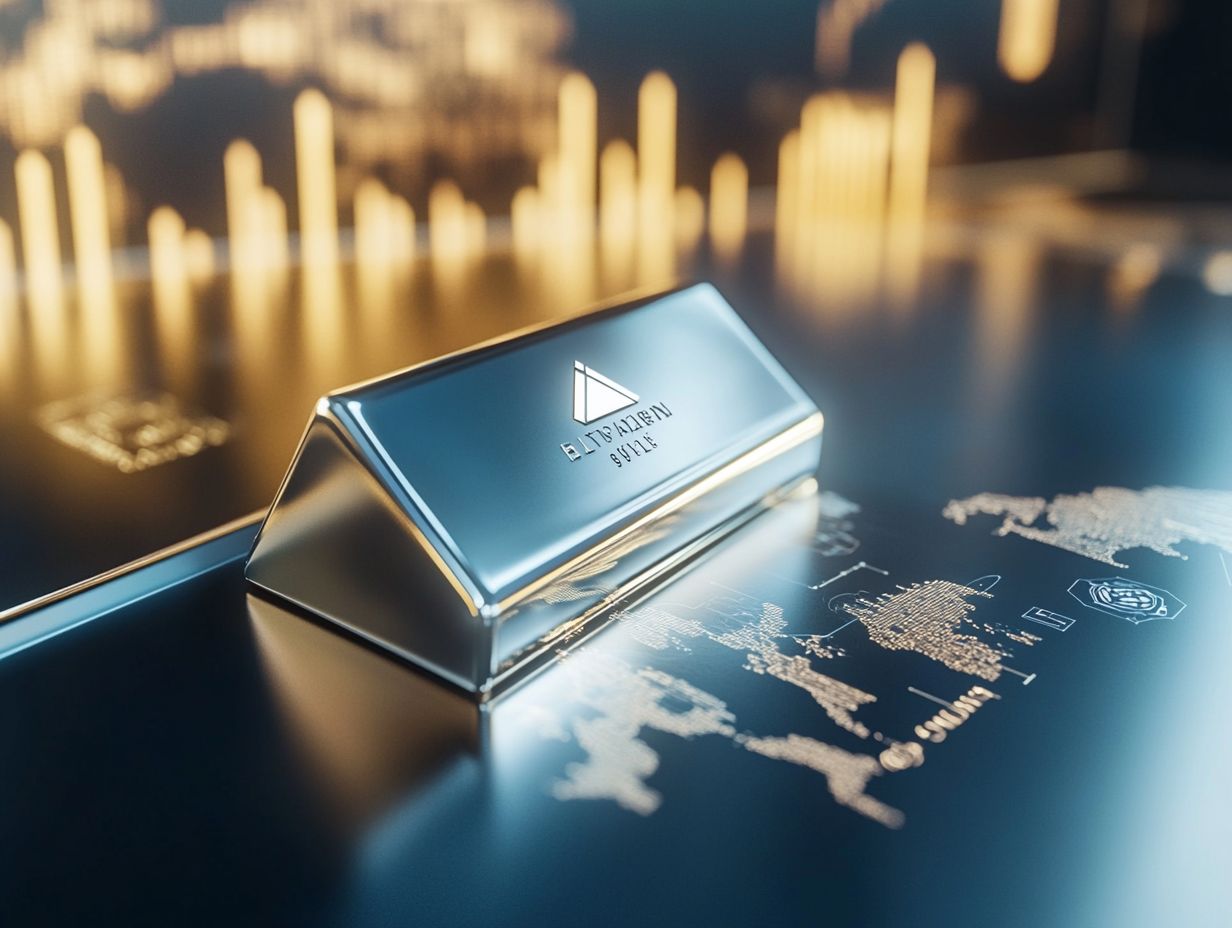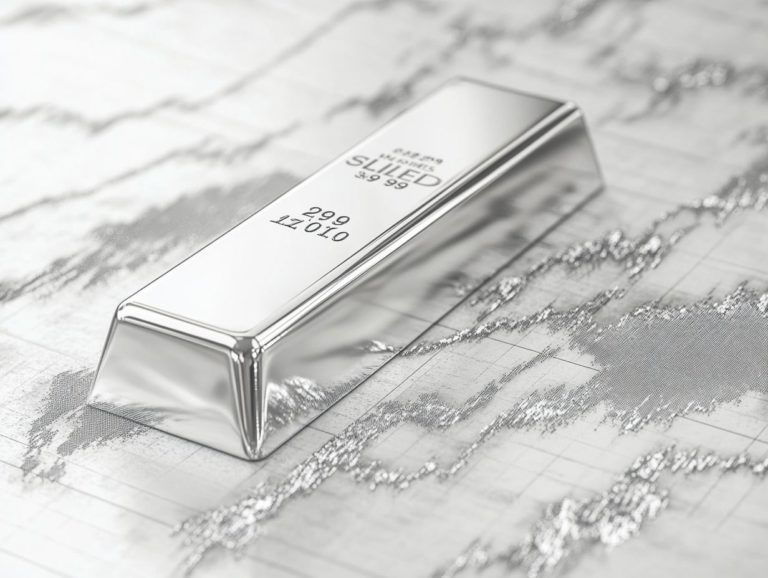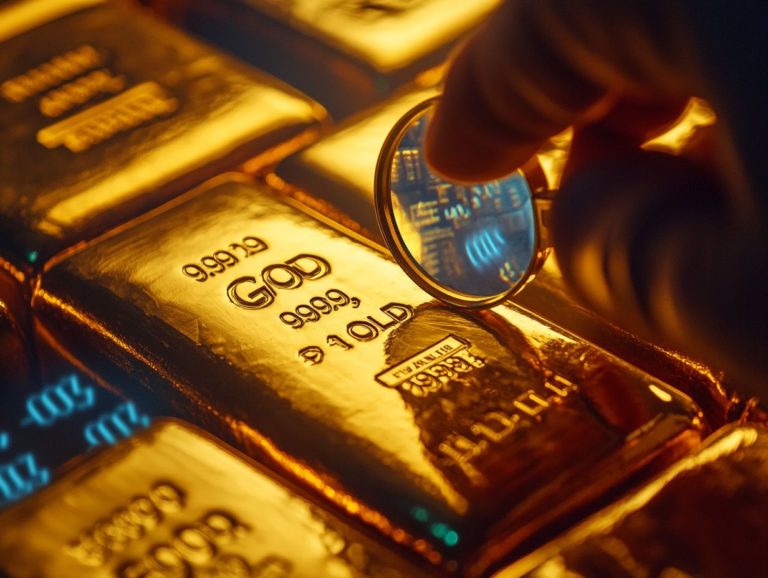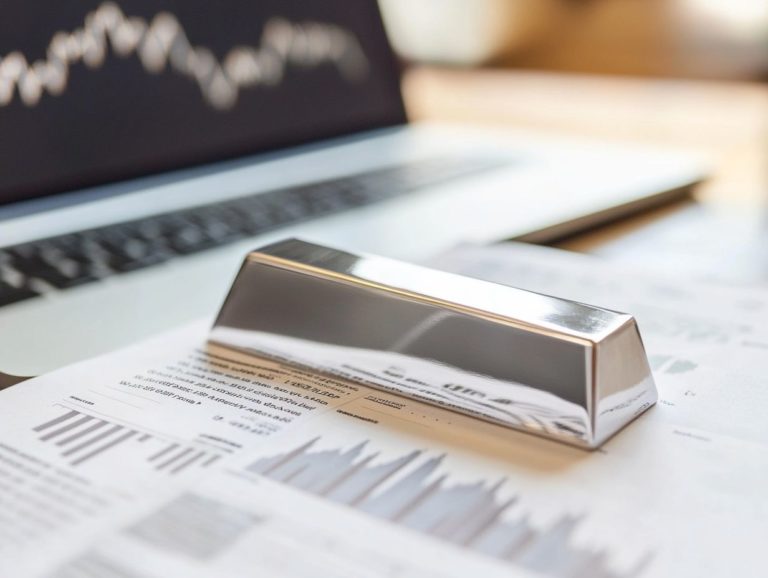Platinum Demand: Current Trends Explained
Platinum, a precious metal celebrated for its rarity and versatility, holds significant importance across a range of industries from automotive to jewelry!
Discover how platinum is used in various industries! This article explores the economic and industrial factors that drive demand and current global consumption patterns. You will gain insights into future projections and potential growth areas for platinum, offering a thorough understanding of the dynamics that shape this unique market.
Prepare to uncover the trends and insights surrounding platinum demand today.
Contents
- Key Takeaways:
- Overview of Platinum Demand
- Factors Affecting Platinum Demand
- Current Demand for Platinum
- Future Projections for Platinum Demand
- Frequently Asked Questions
- What is the current state of platinum demand?
- What are the main factors driving the demand for platinum?
- How does the automotive industry impact platinum demand?
- What is the current trend in platinum demand for jewelry?
- What is the role of investment demand in platinum’s overall demand?
- How do changing economic conditions affect platinum demand?
Key Takeaways:

Overview of Platinum Demand
The overview of platinum demand covers several sectors, including automotive, jewelry, and industrial applications. Each plays a critical role in shaping market dynamics.
Recently, considerable fluctuations in platinum demand have occurred, largely influenced by global economic changes. The automotive sector is a significant driver due to the use of catalytic converters, which are devices that reduce harmful emissions.
As you look ahead to Q1 2024, the World Platinum Investment Council (WPIC) offers an intriguing forecast that considers both above-ground stocks and the existing market deficit. These factors could sway platinum prices and pique investment interest!
What is Platinum Used for?
Platinum stands out as a remarkably versatile precious metal, essential in the automotive sector. It plays a crucial role in the production of catalytic converters, enabling cleaner emissions and enhancing environmental responsibility.
Its unique properties open doors to applications in jewelry, industrial processes, and cutting-edge technologies like hydrogen fuel cells, technology that converts hydrogen into electricity, helping to create sustainable energy.
This metal’s exceptional resistance to corrosion and high melting point make it well-suited for challenging environments, significantly bolstering its value in sectors such as electronics and chemical manufacturing.
As the automotive industry increasingly embraces eco-friendly practices, the demand for platinum in catalytic converters continues to rise, effectively minimizing harmful emissions.
In the jewelry market, platinum’s rarity and lustrous finish attract consumers seeking elegance and durability. The emergence of applications like hydrogen fuel cells could potentially revolutionize energy systems, indicating a growing demand for platinum as industries shift towards more sustainable solutions.
This transition suggests a promising surge in platinum’s market value and a re-evaluation of its role in modern technology!
Factors Affecting Platinum Demand
Several factors significantly influence platinum demand, with market dynamics reflecting the interests of the automotive, industrial, and investment sectors.
As the automotive industry adapts to stringent emission regulations and the rise of electric vehicles, the traditional demand for platinum in catalytic converters faces new challenges. Macroeconomic trends are also crucial in shaping the overall investment appetite for platinum.
It s essential to monitor these indicators as you navigate this evolving landscape.
Stay updated on platinum trends and investment opportunities!
Industry Trends and Economic Factors

Current industry trends and economic factors affect platinum prices and impact your investment strategies in precious metals. Automotive demand is changing due to the rise of electric vehicles and new regulations. This can lead to big changes in platinum’s value.
Insights from the World Platinum Investment Council (WPIC) regarding supply dynamics illustrate the complexities you encounter while navigating these economic challenges.
The shift toward electric vehicles is particularly pivotal. This transition could dampen platinum demand while sparking increased interest in alternative technologies and metals.
As you consider your investment decisions, ongoing global economic factors such as inflation rates and trade policies add another layer of complexity to these market dynamics. The WPIC’s data on production levels and potential shortages provides valuable context, helping you identify opportunities or hedge against risks associated with fluctuating platinum prices.
Current Demand for Platinum
The current demand for platinum showcases its diverse applications worldwide, particularly in the automotive sector, jewelry, and industrial production.
At this moment, the automotive industry stands out as one of the largest consumers of platinum, propelled by stringent emission standards that necessitate highly effective catalytic converters.
Meanwhile, the jewelry sector continues to flourish. Investment demand particularly in platinum ETFs is gaining momentum among investors eager to diversify their precious metals portfolios amid shifting market conditions.
Global Demand and Consumption Patterns
Global demand for platinum fluctuates significantly by region, shaped by varied consumption patterns across the automotive, jewelry, and industrial sectors. Countries like South Africa, Russia, China, and India are major players in the platinum market. Understanding their unique trends can help you navigate your investments.
In South Africa, the largest producer, platinum demand is closely linked to the automotive industry, especially its vital role in catalytic converters. For a deeper insight into this relationship, check out understanding the market dynamics of platinum. On the other hand, Russia tends to focus on industrial applications, which substantially influences its export strategies.
Meanwhile, in China, a growing middle class has ignited rising interest in platinum jewelry, while India continues to demonstrate robust demand, fueled by cultural preferences for precious metals. For those interested in understanding how these factors influence market movements, exploring platinum prices: historical trends can provide valuable insights. These distinct regional trends showcase different consumer behaviors and illustrate how shifts in one area can create ripples throughout the entire sector.
Future Projections for Platinum Demand
Future projections for platinum demand reveal a complex landscape. Factors such as evolving technologies in the automotive industry and growing interest in hydrogen fuel cells will significantly impact demand. Be ready for market changes as we move toward 2024 and beyond.
The projected market deficit will likely influence investment trends, presenting both opportunities and challenges for stakeholders in the platinum market.
Predictions and Potential Growth Areas

Predictions regarding platinum demand indicate several potential growth areas, particularly within the automotive sector and emerging technologies such as hydrogen fuel cells. As the global landscape shifts toward sustainable energy solutions, the demand for platinum in these applications is expected to rise, attracting greater investment interest.
This trend opens up opportunities for you, whether you’re a platinum group metal (PGM) miner or part of an investment firm. You can capitalize on the anticipated growth in platinum prices.
With automakers increasingly prioritizing electric and hydrogen-powered vehicles, the role of platinum as a catalyst in fuel cells is becoming more critical than ever. These advancements not only boost vehicle efficiency but also align with regulatory pushes for cleaner emissions.
Industries beyond automotive, such as renewable energy and chemical production, are recognizing platinum’s unique properties, further diversifying its applications. You can strategically position yourself by exploring partnerships in research and development, tapping into innovative technologies, and understanding market dynamics.
This proactive approach empowers you to seize the rising platinum demand in a transforming energy landscape.
Frequently Asked Questions
What is the current state of platinum demand?
Platinum demand remains stable due to its widespread use in jewelry, automotive, and chemical manufacturing.
What are the main factors driving the demand for platinum?
The primary drivers of platinum demand include its unique physical and chemical properties, increasing industrial applications, and growing consumer interest in luxury goods.
How does the automotive industry impact platinum demand?

The automotive industry is one of the largest consumers of platinum, primarily due to its use in catalytic converters, which help reduce harmful emissions from vehicles.
What is the current trend in platinum demand for jewelry?
Jewelry remains the largest source of platinum demand, with a steady increase over the years due to its rarity, durability, and aesthetic appeal.
What is the role of investment demand in platinum’s overall demand?
Investment demand for platinum has risen due to its potential for hedging against inflation and its use in industrial and technological advancements.
How do changing economic conditions affect platinum demand?
Fluctuations in the global economy can significantly impact platinum demand, as it is a highly industrial metal that depends on economic activities such as manufacturing and infrastructure development.
Act now to take advantage of the growing interest in platinum!














